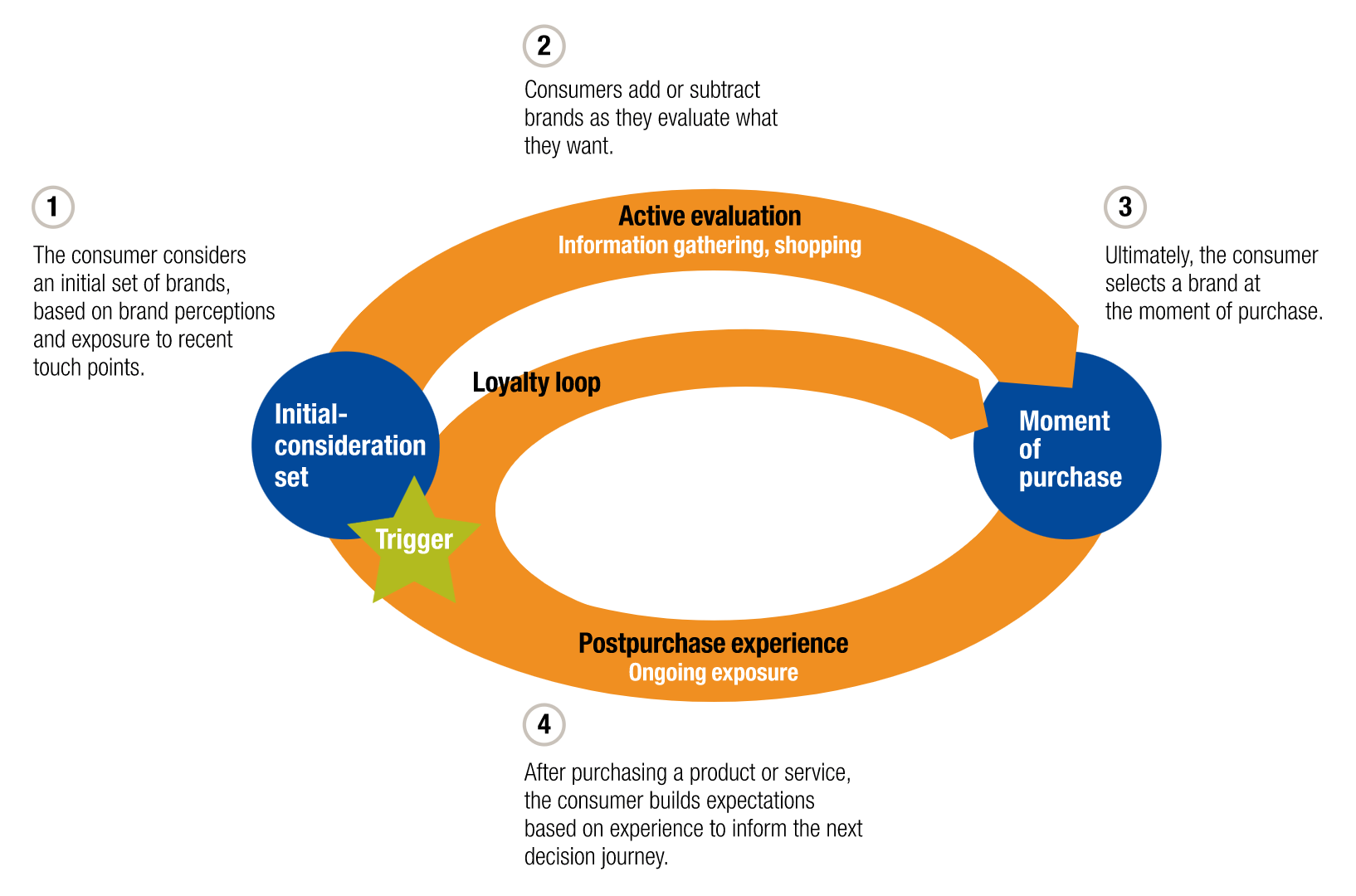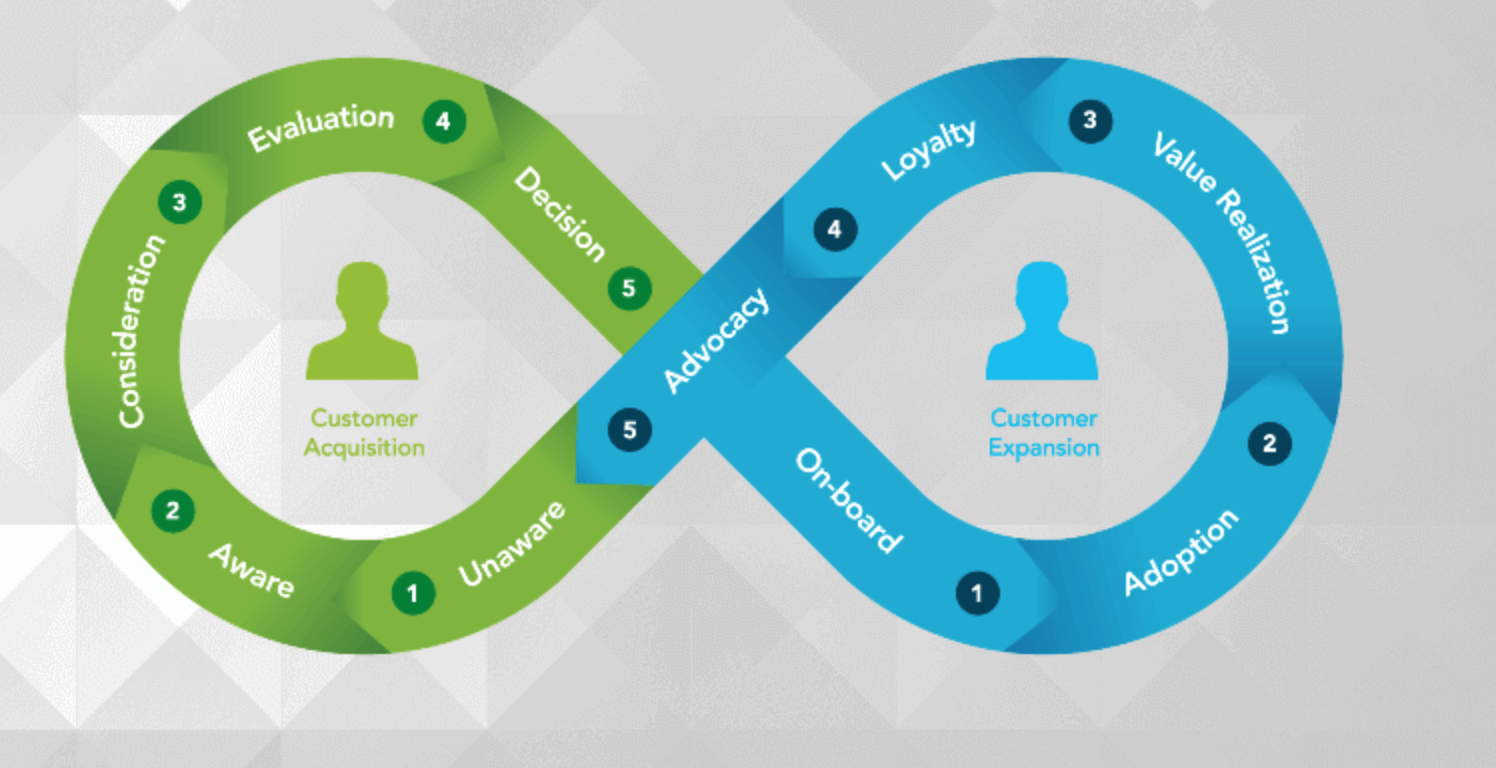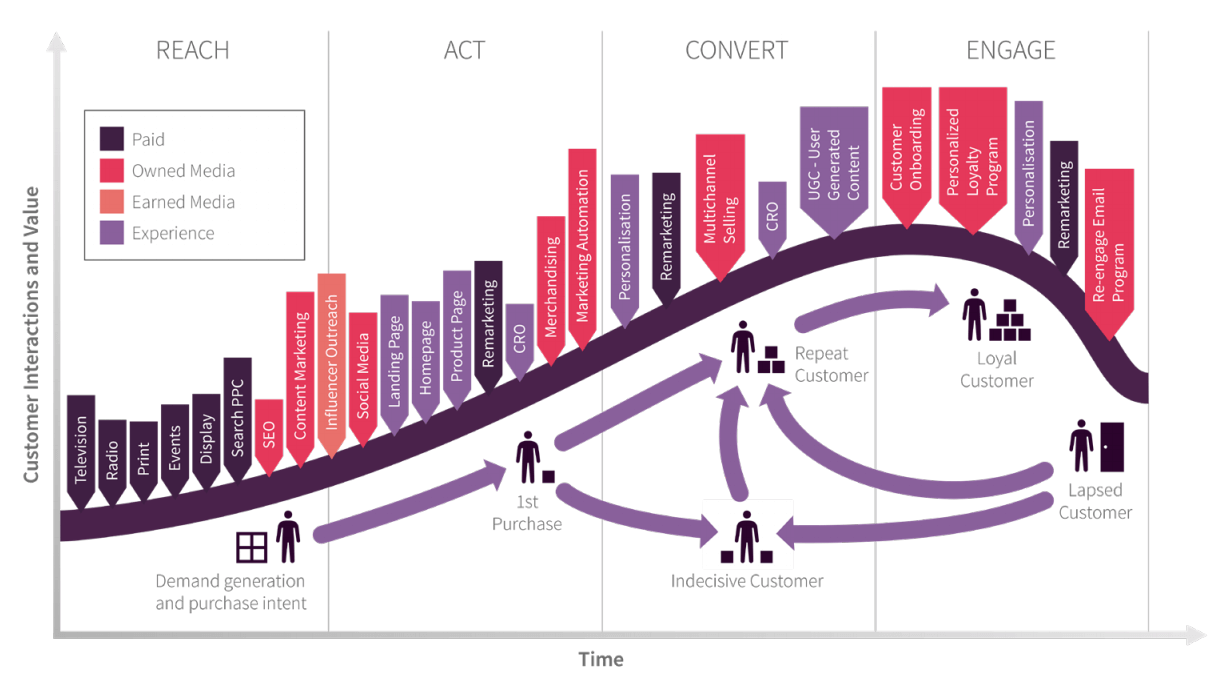McKinsey's consumer decision journey model helps you identify the moment of purchase, while the RACE Framework helps you build a strategy to get there. Use these customer journey models to win more customers
Based on empirical research, in 2009, McKinsey & Company suggested dramatic alternative customer journey models to the traditional purchase funnel. Their research was founded on interviews with 20,000 businesses in the USA, Germany, and Japan.
They recommended a loop model instead of the usual straight-line approach from awareness, purchase, and loyalty. This was a dramatic change although many companies are still, many years later, working on the usual linear approach in a non-linear world.
This is one of the most widely referenced digital marketing models mentioned by brands and agencies, so we use it to start this section. It has spawned many imitative customer journey models including Google’s ZMOT and The Loop from the Pedowitz Group.

[Editor's note (Dave Chaffey). I like The Loop from the Pedowitz Group since it is clearer and it has a nice symmetry. I also like the emphasis on customer retention / expansion and that it highlights the importance of onboarding which has arguably increased in importance with the move to digital direct-to-customer models.

The RACE Framework
We created RACE as a planning system since we found that many people didn’t know where to start when structuring a plan to cover the many paid, owned, and earned inbound marketing activities available to encourage purchase as shown in the below lifecycle visual.
RACE is a practical framework to help manage and improve results from your digital marketing. Ultimately, it’s about using a data-driven approach, applying web analytics and recommended best practices to get more commercial value from your investments in digital marketing.

Notice how we have defined four steps of engagement across the customer lifecycle since in online marketing there is a major challenge in gaining initial interaction and creating those all-important leads after the initial customer touchpoint which can then be nurtured.

How can I use these customer journey models together?
The consumer decision journey empowers marketing leaders to plan, manage and optimize their marketing activities geared to achieving the moment of purchase.
By reviewing each stage within the purchase loop, marketers can discover where there may be gaps and lost sales opportunities.
Moreover, implementing the RACE Framework to track and improve marketing activities at key stages in the customer journey model enables marketers to increase their conversions.
Our RACE Framework is a popular marketing structure framework for Startups, SMEs, and international corporations, since it can scale up or down according to your short-term and long-term objectives. Simply put, RACE guides marketers through a 5-step process of plan, reach, act, convert, and engage, to acquire and retain more customers. Book your free 1-2-1 consultation call today to discuss the challenges and opportunities in your marketing strategy using the RACE Framework. Need a winning marketing strategy?
Book your free 1-2-1 consultation to develop your new strategy with the RACE Framework
Book consultation
How to use McKinsey's consumer decision journey
Align – be part of the initial consideration
Ensure the business is aligned to the customers. Fish where there are fish! No point using Facebook if customers don’t use this channel. One of the challenges is that business to business (B2) often feel the need to establish a Facebook channel even if their customers don’t use it.
Link – integrate all aspects of the brand
Many companies understand the nature of branding better and the need for consistency in terms of promotion and identity. The one area where it can go wrong, is in staff messaging.
Don’t you hate it when you have purchased from a company several time and there’s one offer on Facebook, a different promotion elsewhere and they forgot to tell you? This element ensures consistency which is a key theme through all digital marketing as customers will soon share errors or omissions.
Lock - Find ways to retain customers’ interest
Retaining and “locking customers in” to ensure your company is front of mind, or the first to search, may include moving outside social spaces and running competitions or offers to capture data such as email addresses. This takes the conversation from one to many to one to one.
The lock concept has been developed by many companies when they provide loyalty cards. Using the data can show when customers buy, their spend (your share of the wallet) and favourite items which can lead to timely and relevant offers. Starbucks often send their customers who have registered a top-up card (these became more popular when the Apple watch was launched) offers and it seems these occur when there has been no visit in a two-week period.
Loop - Explore ways to build advocacy
To always be front of mind and ensure customers think of you when they require that product or service is a challenge and this is the element that McKinsey refer to as the loop element. McKinsey quote Amazon as the company that has best achieved this. However, this is why companies build apps, it makes the entire purchasing and re-purchasing process easier. Amazon has an app, a one-click purchase path and has removed every obstacle in the way of the buyer.
How to use the RACE Framework
Plan
Plan measures show the overall contribution of digital marketing to a business. These are financial, market and customer measures taking the most important metrics from other parts of RACE.
- Online revenue and profit contribution: The percentage of direct sales from online channels or influenced by online channels
- Online audience and market share: What online share of visits or conversations compared to competitors does a brand have
- Customer satisfaction ratings: What are the ratings of the business compared to others and what influence does the digital experience have on this, for example, measured through Net Promoter Score (NPS)
Reach
Reach involves building awareness of a brand, its products, and services on other websites and in offline media in order to build traffic by driving visits to different web presences like your main site, microsites, or social media pages
Act
Act is short for Interact; it’s about encouraging interactions. In practical terms, it involves two main techniques: improving your content strategy and the digital experience of your website and mobile to support prospects on the ‘path-to-purchase’.
These ‘Interactions’ include finding out more about a company or its products, searching to find a product or reading blog posts or social media interactions.
It’s about persuading site visitors or prospects take the next step, the next Action on their journey when they initially reach your site or social network presence.
Convert
Convert is about communications techniques to increase conversion to sale. It involves getting your audience to take that vital next step which turns them into paying customers whether the payment is taken through online e-commerce transactions, or offline channels. Often conversion will include both online and offline channels.
This means, for businesses selling online, the most important measures are about value and cost:
-
Sales: Sales volume, conversion rate and cost per sale (or cost per acquisition, CPA). May include online sales influenced offline.
-
Revenue or Profit: These financial measures should be compared to other channels.
-
Average order value: Also known as average selling price (ASP).
Engage
Engage involves long-term customer engagement. It’s aimed at building a long-term relationship with first-time buyers to build customer loyalty as repeat purchases using communications on your site, social presence, email, and direct interactions to boost customer lifetime value.
Email marketing, social media communications, and website content for existing customers are key techniques to support Engage. Note that all of these are important throughout the stages of RACE, but we focus on them in Engage for convenience and since they are arguably most effective as customer communications techniques.
If you're looking to optimize your marketing strategy, integrate your digital activities, or just need some help prioritizing next steps to grow your business, I recommend booking a free 1-2-1 consultation call with the team. Our consultation calls are designed to put you in the driver's seat and talk through your opportunities using the RACE Framework, so you can make an informed decision about the best strategy for your business. Book your call to find out more.
Need a winning marketing strategy?
Book your free 1-2-1 consultation to develop your new strategy with the RACE Framework
Book consultation
Choosing a customer journey model to suit your objectives
McKinsey's consumer decision journey is a great place to start for pinpointing what triggers the moment of purchase for your customers. However, the model is focused on an end-to-end purchase in consumer markets and may be less applicable in the business-to-business arena where there is a much larger or longer purchasing sequence.
The RACE Framework has the benefit that it can be scaled up and down, and applied to any length of purchase cycle across B2B, B2C, and D2C. It is designed to integrate within your existing strategy, or help you create a new one using research and analysis models such as McKinsey's.
Another similar model is Google’s ZMOT model, Zero Moment of Truth, which is particularly relevant to retail purchases and e-commerce.












